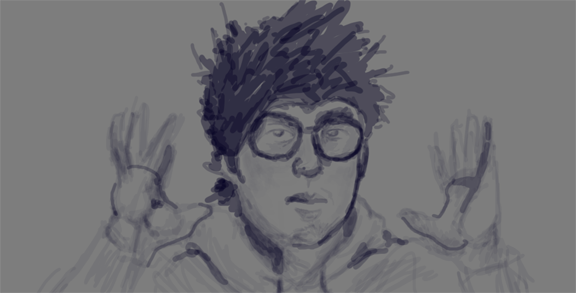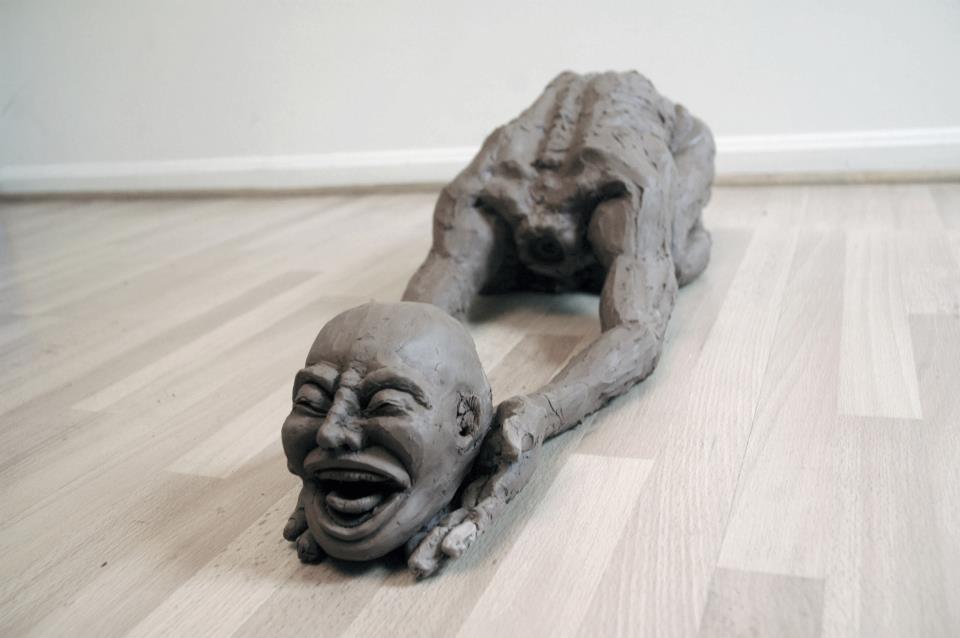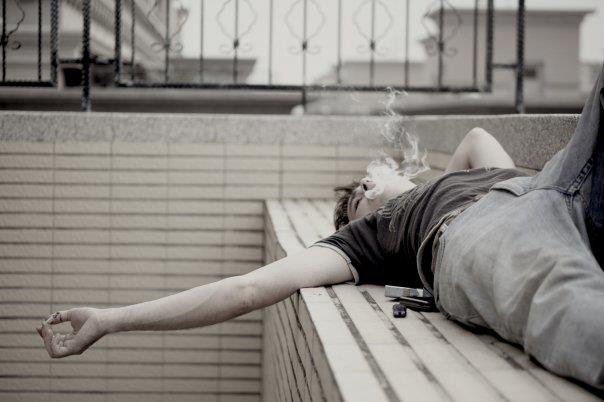I was given one rule: make it aesthetic. Knowing Frank, I wasn’t surprised. And since Frank was kind enough to vomit +3000 words into this interview twice (funny story: we went back and forth through Facebook, and then Frank’s account got deleted for many violations [rather unsurprising], which deleted the entire first interview), I’ve made the [...]

I was given one rule: make it aesthetic. Knowing Frank, I wasn’t surprised. And since Frank was kind enough to vomit +3000 words into this interview twice (funny story: we went back and forth through Facebook, and then Frank’s account got deleted for many violations [rather unsurprising], which deleted the entire first interview), I’ve made the following accommodations:
- I busted out my WACOM tablet and sketched Frank for the header to this post. (Not that this sketch would indicate, but I was one inch away from going to school for art. It’s been years since I’ve done anything remotely artistic though, so cut me some slack.)
- I eliminated my questions from the interview, forcing you to create your own interpretation of the original question asked.
- I bolded the first gleaming thought of Frank’s replies.
If you couldn’t tell, the Frank I’m referring to is none other than Frank Yang. If you know of him, sit back and enjoy. If you don’t know of him, prepare yourself…on many levels.
Why Frank Yang?
I first found out about Frank when he released his rather famous (shall I say, infamous?) training mixtape on YouTube. The video drew quite a buzz. Many bashed Frank’s technique and antics. Others loved his eccentric personality. One thing was for sure: he was pretty damn strong for his size, and pretty damn explosive too.
Frank continues churning out regular videos on his YouTube page, often mixing his thoughts on training, psychology, philosophy, biology, and aesthetics, all while showcasing his subversive shenanigans.
Although I’m personally more reserved (I wouldn’t deadlift naked, have to apologize on national television for clowning a monk, or drink a gallon of milk and eat twenty bananas while doing suicides), I’ve always shared common ground with Frank as we both — as Frank puts it — are all about exploring the infinite possibilities of consciousness/brain/mind-body connection. (Hence lucid dreaming.)
Frank Yang’s Thoughts

All those different activities that I engage in — music, weightlifting, bodybuilding, philosophy, trolling, art, film making — are all just different manifestations of a very simple idea: to take the mind to extreme places and explore what it means to be human by playing with the one organ that makes us who and what we are.
The whole idea of “mindfucking” is that when your mind is blown away, it means that somebody or something gave a little push to your normal state of consciousness, shifting it to a different zone. I think these moments of epiphany, big or small, are the defining characteristics of what it means to be human. Because the brain is the most complex system in the known universe, and because ultimately it is the tool and weapon for our survival and the success of our species, much like the speed of cheetahs or the jumping ability of grasshoppers.
It is almost a human right to experiment with this organ and explore its endless possibilities. I think the desire to want to experience different modes of consciousness is as innate as the desire for love and sex. I mean even the feeling of love itself is simply a manifestation of very unique state of mind.

Athletes like Kobe Bryant and Muhammad Ali are the kings at doing this. To me, they are the ultimate mindfuckers: the way they visualize their performances beforehand, making plays or moves happen in their heads, bringing them into reality the way they envisioned, and the way they intrude their opponents and fan’s mental spaces by making them witness superhuman performances.
Their bodies are merely vehicles for their extreme states of minds. Think of a runner’s high, the way lifters psych themselves up and how they celebrate after they complete the lifts, or the mental focus of a sprinter before the blocks. They could all be said to be “in the zone.” And this “zone” is this extreme state of consciousness that I keep referring to. An artist experiences this, and so does an athlete.
Relative strength is EVERYTHING when it comes to vertical jump. Or should I say, 2 legged, standing vertical jump without steps or a running start, which by its strict definition, is the only movement that can be labeled a “vertical jump”. When you see basketball players running and jumping off of 2 feet, they aren’t performing a vertical jump. And usually 1 legged jumps don’t depend so much on relative strength and power inputs as the true 2 legged vertical jump.

Like being right or left brain dominated, people are usually divided into 1 legged jumpers or 2 legged jumpers, based on bone and muscular structures, and it’s very rare to see an athlete who can perform both because being good at one side usually means suppressing the other. In a nutshell, 1 legged jumpers are usually the “bouncy” and “springy” jumpers who rely more on reactive strength, elasticity, and genetics. 2 legged jumpers are more or less “power” jumpers who rely more on strength and power. When you see someone taking off with 1 feet after a good running start, it’s usually a very graceful movement.
Anthony’s note: I have also jumped 40″, and I’m a bilateral jumper. I jump highest with a coast into a bilateral jump, rather than unilateral. For whatever reason, this surprises people as they think jumping off of one leg would get you higher (likely because that’s what most NBA folk do…never mind that they are seven foot tall…
On the other hand, power jumpers usually rip the floor off at the take off because the power in and output are so immense. And because relative strength plays more of a role in 2 legged jumps, it is easier in theory to improve one’s standing vertical jump. The reason why relative strength is important is simple science: power = speed x strength, and the vertical jump is one of the purest expressions of power a human being can produce.
The speed part of the equation is harder to improve because it relies on reaction time and CNS efficiency (how fast your central nervous system fires and how many muscle fibers they can recruit), and such attributes are mostly determined by genetics. The strength part of the equation, however, is much easier to improve. Even not-so-quick and not-so-athletic humans can improve their strength by adding more weight onto the bar in the squat rack consistently and with the right training. So in theory, and perhaps potentially, relative strength is important because the stronger you are relative to your body weight, the higher you can jump and the faster you can run because your power output is higher.
A 150 pound person who can squat 400 pounds is definitely going to jump higher and sprint faster than a 300 pound person who can squat 400 pounds (insert my favorite car analogy by replacing your Corolla’s engine with a truck’s to see how much faster it would go from 0 – 60) given that they both worked on the correct technique. However, having strength is not the only story.
I have seen light weight powerlifters who can move a ton of weight, yet can’t jump for shit. Why is this? Their CNS isn’t efficient enough to command the muscles. They have the basic material to jump high and run fast (strength), yet they don’t have the neural efficiency and reactive ability to transfer and convert that strength quickly enough to turn it into power.
The 1RM squat or deadlift isn’t a power movement because it doesn’t really take a lot of speed to squeeze out all that strength in your body to lift up that weight. In a vertical jump, however, speed is a crucial part of the equation because jumping itself is a very quick movement. If you can’t “turn on,” “collect,” and “use” your strength during that 0.7 second that takes you to complete a jump, all that base strength is useless!
Relative strength is a must in a movement like a vertical jump. But it isn’t the only attribute one has to have in order to jump high, or sprint fast. So the best way to train the vertical jump is to take care of both the speed and the strength side of the equation.
To train your strength: lift heavy weights and try to become stronger by increasing your 1 RM in the squat and deadlift.
To train speed: focus on movements that train the nervous system to “fire” your muscles as quickly and as efficiently as it can by performing shock training.
Put the 2 together, and you have a big vertical jump.
My best lifts: 405 pound squat, 500 pound deadlift, and 300 pound bench press (all done at around 160-165 bodyweight). Vertical jump: 40 inches. Forty yard dash: 4.5 seconds.

Eric Cressey was a great coach. He made my vertical and strength go up with nothing but words of wisdom (he coached me online), although I did not perform Olympic lifts under his guidance. He felt that Olympic lifts were too technical to perfect, to get anything out of them with less than good form would be a waste of time.
Even though Olympic lifts CAN and DO increase explosiveness, and the fact that Olympic lifters are often very explosive, they are not the only lifts that can increase speed and vertical jumps. The two Olympic lifts – the clean and jerk and the snatch are power movements that fall in the middle of the speed-strength continuum. Doing only those 2 lifts can get you some explosiveness, but they do not cover the extreme ends of this continuum.
The two exercises that I talked about earlier, the squat and the depth jump (shock training) are, however, the best and most extreme examples of the opposite ends of the speed-strength continuum. What I am trying to say is that squats and depth jumps are much easier to learn in terms of techniques, and getting stronger at the squat and getting more explosive/quicker at the depth jump will be enough to cover the entire spectrum of the speed-strength continuum to increase the power of the athlete.
I’m not saying that one shouldn’t do Olympic lifts at all. It might be very beneficial to throw in a few sets of power cleans in your routine. What I’m saying is that the time it takes to perfect these lifts can be spent on other things like hitting squat PRs and doing balls-to-wall deadlifts. In a nutshell, you don’t NEED the Olympic lifts to become explosive. If you want to throw in explosive lifts into your routine, I would recommend speed deadlifts and speed box squat with chains or bands.
Anthony’s note: If you’re looking for an incredibly long, mildly informative guide as to whether or not Olympic lifts should anchor your training program, I just happened to write one. It’s similar to Frank’s thoughts, so check it out here.
In terms of movements that don’t exactly mimic a vertical jump, or the fact that deceleration in certain lifts such as a speed deadlift are said to “slow you down”…I don’t really buy that idea.
No movement you perform at the gym is going to look or feel anything like what you do away from the gym, whether you are jumping, sprinting, or sparring. You are trying to build strength and muscles at the gym – tools that will have carry over to your practical movements on the field. This does not mean that you should literally “imitate” the particular movement that you are trying to improve.
I see guys doing half squats at the gym and when I ask them why they don’t go all the way down, their replies are always something along the lines of: “I’m a basketball player and I’m training for my vertical. You never go down that low when you jump or play ball anyway.”
That is a false mindset.
When you squat, you should always go down deep not because you are trying to mimic the jumping motion with the squat, but because deep squats build muscles that are important to a movement like the vertical jump. As long as you practice the movement itself (if you want to be good at sprinting, you gotta SPRINT; If you want to jump higher, you gotta practice JUMPING), the weight exercises themselves aren’t really going to have an effect on your movements outside of the gym. For instance, the walking lunge is one of the best exercise to do to increase the vertical jump, one that looks nothing like the vertical jump itself.
The squat: the king of all exercises. This one hits all the major muscle groups for sprinting and is a great way to train the nervous system to recruit muscle fibers when doing it heavy.

The deadlift: the difference between a deadlift and a squat can simply be the difference in where the weight is. In the squat it’s on your back, and in the deadlift its in your hands. So I find deadlift a crucial exercise in developing lower body strength, because it allows you to get stronger while taking the bar off of your back once in a while.
The bulgarian split squat: the BEST unilateral strength exercise and for me the most painful exercise ever! I always get the most sore after this exercise, and sometimes for days, especially in the arse. Which is a great feeling when you go to the toilet because you know those gluteus are getting hammered each time you perform them.
The glute ham raise: if you have a glut ham raise machine, use it after every leg work out. I used to do them under all variations – explosively, with bands, with weights, high reps to failure. Unlike the leg curls, where the hamstrings are worked out in isolation, the glute ham raise allows the hamstring to be activated and stimulated in synchrony with the glutes and low back in a continuous and functional movement.
The one legged squat: if the pull up is the exercise to test out your relative strength for the upper body, the 1 legged squat is the ultimate tester to see where your relative strength, conditioning, and flexibility levels are. Most so called “athletes” can’t even perform 5 strict reps of unassisted 1 legged squats.
Other than what I mention before about pushing the limits of the mind to experience altered state of consciousness, reductively speaking, from a biological standpoint, they are all just means to get laid! I outlined some of my thoughts on this subject in this article.

Whether you are trying to get stronger at the gym, to become a better basketball player, a better orator, physicist, painter, sculptor, musician, etc, at the end of the day your goal, consciously or subconsciously is to turn on women and convincing them that you more genetically fit than other male competitors. Since females, by their biological design, have only 1 precious egg a month vs the millions of sperms a male can produce on a daily basis, they are the more selective sex when it comes to courting. This explains why males are the more “accomplished” sex in the arts and sciences, and why not a lot of people care about female athletics.
Now, obviously not all of us literally think about pussy every time we lift or paint. What I’m talking about here is that as carriers of genes that have to find their way to the next host/generation via offspring at all costs, we designed, over millions of years of natural selection, to have bodies and brains that automatically find certain things pleasurable: sex, food, and of course, success and glory.
You could say that there really is no difference, for me, between playing a violin concert and getting an aesthetic physique. Mastering the arts is as much of an indication of good genes as having a great body.
While the men who fall under the category of “alphas” usually belong to athletic crowds, great artists and musicians, thinkers and writers should also be labeled alpha because having a good brain is equally important. Humans are, after all, a pretty weak species physically, and can really only rely on brain power to survive. With that said, it goes without saying that acquiring an aesthetic mind is equally important, if not more important than building an aesthetic body.
Making art and playing music have also helped me cultivate my imagination, a key factor in athletic performance.
I always tell people that if I my mom never made me play the violin when I was 5, I would never have a 40 inch vertical jump! Other than discipline and the perseverance, playing the violin taught me how to visualize movements down to their last details.
Having a good imagination is an important key to athletic success. The ability to visualize motor skills and physical actions clearly and distinctively in your mind is essential because when you actually perform and carry out these actions in reality, your neurons are already primed to do so. Kelly Baggett mentioned that most explosive athletes are right brain dominated…in other words they are good visualizers and imaginers who can hold clear images of what they wish to create or become in their minds. They have practiced their movements over and over again in their minds so that their neurons are already firing and connecting before the movements were actualized in reality.
There really is little difference between making sculptures and jumping. Both endeavors are creative in nature, as both are acts of transferring what you visualize in your mind into reality. The better you are at generating and manipulating these images in your head, the better your “products” in reality will turn out to be. In sculpture, the products are of course, the sculptures themselves. But in lifting and in jumping, the product is the body performing the movements primed by the mind.
I did coach a few of my friends over the years. They weren’t official my client, they were more like my training partners who weren’t as experienced or as strong as I was and needed my guidance. They also helped me out a great deal by challenging to surpass me at all times, and of course, loading my plates and putting my weights back. But over the years, I have seen many of my training buddies become stronger and stronger.
The most important thing I gave them is the importance of training “smart”. When I met most of them, none of them did any leg work other than quarter squatting on the smith machine. What I am proud to say now is that even though most of my training partners don’t train with me anymore, years later, no matter what their goals are, they are still squatting ass to grass year round!
++++++
Want more of Frank? You can connect with him on his Facebook Page or YouTube Page.
All photo credit goes to Frank Yang.